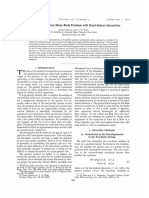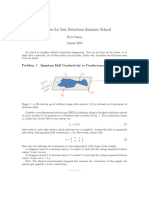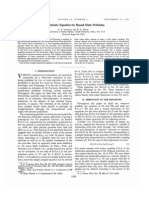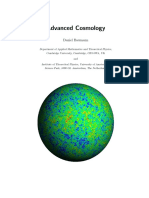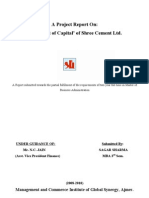PhysRev 105 1119
PhysRev 105 1119
Uploaded by
嵓雨Copyright:
Available Formats
PhysRev 105 1119
PhysRev 105 1119
Uploaded by
嵓雨Original Title
Copyright
Available Formats
Share this document
Did you find this document useful?
Is this content inappropriate?
Copyright:
Available Formats
PhysRev 105 1119
PhysRev 105 1119
Uploaded by
嵓雨Copyright:
Available Formats
LETTERS TO THE ED ITOR iii9
The absorption mechanism discussed here is not —(2J+1)g;(—s)
limited to n type materials. A somewhat similar mech-
Vp/kT=V Q b(s'=
1
anism should also be operative in p type specimens
according to the interpretation of elastoresistance given —2J (2J+1)Lg; ( —s) ]'(a/X)
by Adams. 7 Here the mechanism involves scattering
from one part of the distorted Fermi surface to another —g J'(2 J+ 1)g:( —s) [g:(—s)]'(a/l )'
part of the same energy surface. One would expect the
relaxation time for this mechanism to be considerably
where
shorter than for intervalley scattering.
' R. W. Keyes, Phys. Rev. 103, 1240 (1956). (s) P I nsl- (2)
' J. Bardeen and W. Shockley, Phys. Rev. 80, 72 (1950). l=1
' C. Kittel, Acta Metallurgica 3, 295 (1955).
4
C. S. Smith, Phys. Rev. 94, 42 (1954).
~
C. Herring, Bell System Tech. J. 34, 237 (1955). F= P (rsvp) «(r+s) —
'(r+t) —
's~'+'. (3)
A. Granato and R. Truell, J. Appl. Phys. 27, 1219 (1956). r, s, t=l
' E. N. Adams, Phys. Rev. 96, 803 (1954).
(B) For the Bose gas, the fugacity expansion is
X'p/kT = g«(s) —2Lg«(s)]'(a/X)
+8g'. ( )Lg-:(s)]'( /~)'+8P( ) (a/~)'+0(a'/~') (4)
Many-Body Problem in Quantum (C) For the Bose gas, the pressure and density at the
Mechanics and Quantum Statistical transition point are given by
Mechanics X'p/kT = 1.34 —2 (2.61)'(a/X)+0[(a/X) '],
T. D. I.EE, Columbia University, New York, %em York 'A'p = 2.61 —4(2.61'.) «(a/X) «+Ofa/X]. (5)
AND
To obtain this expression it was necessary to sum the
C. N. YANG, Institute for Advanced Study, dominant terms in the fugacity expansion to all orders
Princeton, New Jersey
of (a/X) near s=1.
(Received December 10, 1956)
(D) The ground-state energy per particle for a Fermi
gas at a finite density p and infinite volume is given by
HIS is a progress report on some work' concerning
the quantum mechanical calculation of the
fugacity coeKcients b& (which correspond to the classical
cluster integrals) of a Bose, a Fermi, and a Boltzmann
E/)V= (3Pr'/5)+87rapJ(2J+1) '
&& [1+6(11—2 log, 2)Pra/357r+0(Pr'a')] (6).
gas at low temperatures. A "binary collision expansion" (E) The ground-state energy per particle for a Boltz-
method is developed which allows for the systematic mann gas and for a Bose gas at a finite density and
calculation of b~ as expansions in powers of a/X, where a infinite volume is
represents the parameters of the dimensions of length
that characterize the low-energy two-body collision and
E/. V = 47rap[1+ 128 (pa3) «/15m. «+ 0 (pa3) ]. (7)
X is the thermal wavelength. To any power of (a/X) the The parameters of expansion in Eqs. (6) and (7) are
calculation of any specific b& is reduced to a finite number determinable by a simple argument without explicit
of quadratures. The method, therefore, is the low- calculation.
temperature counterpart of the high-temperature The ground-state wave function and the thermo-
expansion of b~. dynamical behavior in cases (D) and (E) near T=O
By going to the limit T~O, the binary collision ex- were also obtainable in these computations. Details of
pansion method can also yield the ground-state energy the binary collision expansion method and the above
and ground-state wave function in a systematic expan- calculations will appear in a later publication.
sion. It also supplies information concerning the density The binary collision expansion met. hod is being
of energy levels near the ground state. applied to a more realistic interaction. Calculation with
The method is applied to the case where the inter- the Lennard-Jones potential is feasible for b~ at low T
action is a hard-sphere interaction with diameter a. The Work in this direct. ion is under contemplation.
J
particles are assumed to have spin J, where is taken to Equa, tions (4) and (6) have been obtained before' by
be zero for the Bose and Boltzmann gases, and left the method of pseudopotentials. By using the same
arbitrary for the Fermi gas. We use the following method it is not diAicult to obtain also Eq. (1). It was
notations and units: A=i, m=mass of particles= — ', emphasized in reference 1 that the method of pseudo-
.V=number of particles, V=volume of box, p=.V/V, potentials is not applicable to all orders of a. With the
Pr = maximum Fermi momentum = L6~'p/(2 J+
1)]«, binary collision expansion method the full range of
and X= (4x./kT) «. The results are tabulated below: applicability of the pseudopotential becomes clear. One
(A) For the Fermi gas, the fugacity expansion is concludes that it should be possible to obtain also Eqs.
ii20 LETTERS TO THE ED I TOR
(5) and (7) by the pseudopotential method. This ~ /Z i i / g i $ i i I I I I I i I
problem was looked into in collaboration with Dr.
Kerson Huang. It turns out that it is extremely simple
to obtain (7) by the pseudopotential method. A detailed .08
description of this computation will be published
shortly.
-JOex
It should be emphasized that the expansions quoted .04
above are probably all asymptotic expansions. One is
led to this conclusion by the following argument. A
small and negative value of a corresponds to the case I I I I I I I ( i
where the force is purely attractive with the scattering 0 50 /00 /50
length — a, for which the gas (for any statistics)
X(cm)
collapses. The formula should therefore become mean- FIG. 1. Regeneration of 8's by magnetic field for y= 6, r =10 "
ingless for negative a. This would result if, for ex- sec, co2 —co1= 1/r1 = AE g (which corresponds to 22. 7 kg if
p = 8A/m~c).
ample, the physical quantities contain such terms as
exp. ——'p —
[ a ']. A long-lived 02 beam can therefore be "quenched"
'A description of the binary collision expansion method, to- by a magnetic field, if the 0' has a magnetic rnornent.
gether with formulas (4) and (5) below, had previously been given For a moment @=ed/nike, the fields and times re-
at the International Conference on Theoretical Physics at Seattle,
1956 (unpublished). quired are about like those needed to rotate a nuclear
' K. Huang and C. N. Yang, Phys. Rev. 105, 767 (1957); Huang, spin by 1 radian, or on the order of 104 or 10' gauss-
Yang, and Luttinger, Phys. Rev. 105, 776 (1957).
feet. The effect could therefore be observed experi-
mentally.
The equation for the regenerated 0& amplitude can be
derived in a manner entirely similar to that of Case. "-
Regeneration of eio Mesons by a
A plot of ~ai ~' vs distance into the magnetic field (ni
Magnetic Field* is the amplitude of Hi) is given in Fig. 1. The values of
MYRON L. Goon the parameters used are: r& 10—"sec, — r2= ~ (T1, 2
Radiation Laboratory, University of California, Berkeley, Calzfor ma =ei 2 lifetime); y=1/(1 —P )'=6, &u~ —~di ——(mass differ-
(Received October 22, 1956) ence frequency) = 1/2ri, and 2pH/A= 1/2ri (for
= «A/mire, this corresponds to a field of 22. 7 iU'logauss).
'HIS letter
is to point out a surprising phenorn- Figure 1 implies that if the magnet is 60 cm long,
enon that should occur if the 0 particle has a 10% of the incident 82's would decay just beyond the
spin and a magnetic moment. The sequence of events is magnet. However, ~ei ~'(1/roc=1/18 cm) is the prob-
shown schematically as follows: ability, per cm of path, for decay in the magnet. Taking
this into account, one sees that the reason the curve is
Oi(tt)+ig~(tt) falling, for magnet length & 100 cm, is that most of the
particles have decayed in the magnet. The effect is
therefore quite large.
It is interesting to speculate whether experiments
= —Hj — -2~. already performed can rule out reasonable values of the
ma&. fie&d decay
magnetic moment. A quick look indicates that probably
A 0 meson is made, in associated production with a this is not the case. Experiments where 0"s are produced
hyperon, and let us say the spin (first arrow) is up. in a magnet cloud chamber do not have much 02 path
After 10 "sec, 0& decay has left only the 02 component length. On the other hand, in the experiment by I.eder-
of the original wave. ' This also has spin up. The 0~ is man et al. ,' a strong sweeping magnet preceded the
part 0', part 0', each of which has, of course, spin up. But cloud chamber. This could have the effect of wiping
the magnetic moment (second arrow) of the 00 will be out all but the nz=0 substate (which is unaffected by
oppositely directed from that of the 0, since it is the the field). This substate would then not regenerate in the
antiparticle of the 0. Therefore, if the 0~ beam, in vac- cloud chamber magnet, since its field was parallel to
uum, encounters a uniform vertical magnetic field, that of the sweeping magnet. Rather, the typical 0~
there will be an energy difference De= 2+8 between the three-body decays would be seen.
8, 0', and a difference Ae/h in their De Broglie fre- * This work was done under the auspices of the U. S. Atomic
quencies. The 0, 0' components will therefore, in time,
Energy Commission.
get out of phase. Once they are out of phase, the M. Gell-Mann and A. Pais, Phys. Rev. 97, 1387 (1955).
particle is no longer entirely a 02, but has a 0& component. ' K. Case, Phys. Rev. 103, 1449 (1956).
3 Lande, Booth, Impeduglia, Lederman, and Chinowsky,
The 0& component then quickly decays into two x Brookhaven National Laboratory Report BNL-2857, 1956
meso ns. (unpublished).
You might also like
- The Oxford Solid State Basics, Solution ManualDocument199 pagesThe Oxford Solid State Basics, Solution Manualolvann86% (22)
- COPPA 2 New Guidelines On Standards and Criteria FR Accreditation of Dental Degree Programmes 2019Document19 pagesCOPPA 2 New Guidelines On Standards and Criteria FR Accreditation of Dental Degree Programmes 2019Ramesh KumarNo ratings yet
- Electrodynamics CaliforniaDocument363 pagesElectrodynamics CaliforniaRamin GoudarziNo ratings yet
- Australian Fish and Seafood Cookbook - John Susman PDFDocument855 pagesAustralian Fish and Seafood Cookbook - John Susman PDFFred Smif100% (5)
- 1984-Gavrila-Free-Free Transitions in Intense High-Frequency Laser FieldsDocument4 pages1984-Gavrila-Free-Free Transitions in Intense High-Frequency Laser FieldsjohanNo ratings yet
- Akarsu 2011Document10 pagesAkarsu 2011Rakesh DabgarNo ratings yet
- Comments On String Theory On AdsDocument47 pagesComments On String Theory On AdsmlmilleratmitNo ratings yet
- Hartnoll, Herzog, Horowitz, Building AdS-CFT SuperconductorDocument11 pagesHartnoll, Herzog, Horowitz, Building AdS-CFT Superconductorfrancisca ramirezNo ratings yet
- Black BodyDocument8 pagesBlack BodyaisyahNo ratings yet
- Difusion y Localizacion en Un Sistema Cuantico Disipativo-Schmid1983Document4 pagesDifusion y Localizacion en Un Sistema Cuantico Disipativo-Schmid1983Liz GcNo ratings yet
- Black Hole Entropy From Near-Horizon MicrostatesDocument11 pagesBlack Hole Entropy From Near-Horizon MicrostatesmlmilleratmitNo ratings yet
- Radial Distribution Function For Argon Calculations From Thermodynamic Properties andDocument11 pagesRadial Distribution Function For Argon Calculations From Thermodynamic Properties andrafelNo ratings yet
- Decay of The PionDocument3 pagesDecay of The PionGuus MulderNo ratings yet
- How To Integrate Planck's FunctionDocument14 pagesHow To Integrate Planck's FunctionMaxtron Evelyn MoonNo ratings yet
- Renormalization Group and The Ginzburg-Landau Equation: Mathematical PhysicsDocument16 pagesRenormalization Group and The Ginzburg-Landau Equation: Mathematical PhysicsNikos PapanikolaouNo ratings yet
- 0401041Document12 pages0401041lodrigaspeNo ratings yet
- Haken 1975Document2 pagesHaken 1975cesar abraham torrico chavezNo ratings yet
- PR 51 WignerDocument14 pagesPR 51 Wignerarunav.verma9793No ratings yet
- Temperature Dependence of Semiconductor Band Gaps: Applied Physics Letters July 1991Document4 pagesTemperature Dependence of Semiconductor Band Gaps: Applied Physics Letters July 1991Mohit RawatNo ratings yet
- Oshaguinessy and ProcacciaDocument4 pagesOshaguinessy and ProcacciaNo HernaNo ratings yet
- Research Article: Critical Phenomena of Charged Ads Black Holes in Rastall GravityDocument9 pagesResearch Article: Critical Phenomena of Charged Ads Black Holes in Rastall GravityIqra YaqootNo ratings yet
- A Modified Expectation Maximization Algorithm For Penalized Likelihood Estimation in Emission TomorzradhvDocument6 pagesA Modified Expectation Maximization Algorithm For Penalized Likelihood Estimation in Emission TomorzradhvDavid SarrutNo ratings yet
- 1 s2.0 0022247X79902348 MainDocument8 pages1 s2.0 0022247X79902348 Mainsatitz chongNo ratings yet
- xeviem A Genera. Ec1 Roi.: YnamicsDocument11 pagesxeviem A Genera. Ec1 Roi.: YnamicsJosé JiménezNo ratings yet
- Gell Mann LowDocument13 pagesGell Mann LowRavi MohanNo ratings yet
- A Scale-Dependent Cosmology For The Inhomogeneous UniverseDocument3 pagesA Scale-Dependent Cosmology For The Inhomogeneous UniverseedmarNo ratings yet
- Troup MechanicsDocument22 pagesTroup MechanicsprivateNo ratings yet
- Universal Diamagnetism of Charged Scalar Fields: Debnarayan JanaDocument16 pagesUniversal Diamagnetism of Charged Scalar Fields: Debnarayan JanaТи КоNo ratings yet
- Current Algebra Applied To Properties of The Light Higgs BosonDocument4 pagesCurrent Algebra Applied To Properties of The Light Higgs BosonChanda Hsu Prescod-WeinsteinNo ratings yet
- Institute, Admmed Studies Center, Carouge-Genetur. SwitzerluadDocument6 pagesInstitute, Admmed Studies Center, Carouge-Genetur. SwitzerluadShubham SinghNo ratings yet
- Physrevd 8 1044Document4 pagesPhysrevd 8 1044mmigthemightNo ratings yet
- JCP84 Gao Prohofsky SCTheo DNADocument3 pagesJCP84 Gao Prohofsky SCTheo DNAYongli GaoNo ratings yet
- You May Not Start To Read The Questions Printed On The Subsequent Pages of This Question Paper Until Instructed That You May Do So by The InvigilatorDocument6 pagesYou May Not Start To Read The Questions Printed On The Subsequent Pages of This Question Paper Until Instructed That You May Do So by The InvigilatorSpringOrchidNo ratings yet
- String Creation and Cosmology: Steven S. GubserDocument11 pagesString Creation and Cosmology: Steven S. GubserJack Ignacio NahmíasNo ratings yet
- Dirac 1959Document7 pagesDirac 1959Louis DeprezNo ratings yet
- A Model For The Big Bounce: Theoretical Physics Division, CERN, CH-1211 Geneva 23, SwitzerlandDocument10 pagesA Model For The Big Bounce: Theoretical Physics Division, CERN, CH-1211 Geneva 23, SwitzerlandJohan LópezNo ratings yet
- Holographic Reconstruction of The K-Essence and Dilaton ModelsDocument17 pagesHolographic Reconstruction of The K-Essence and Dilaton Modelselanor86No ratings yet
- Fugacity Versus Chemical Potential in Nonadditive Generalizations of The Ideal Fermi-GasDocument11 pagesFugacity Versus Chemical Potential in Nonadditive Generalizations of The Ideal Fermi-Gasbohdanka.sobko.dNo ratings yet
- (1992) Diffusion Simulation With Deterministic 1D LGADocument11 pages(1992) Diffusion Simulation With Deterministic 1D LGAGonçalo SilvaNo ratings yet
- PhysRev 105 767Document9 pagesPhysRev 105 767嵓雨No ratings yet
- Aa6307 06Document7 pagesAa6307 06elitegamerx1987No ratings yet
- Anomalous Quantum Hall Effect - An Incompressible Quantum Fluid With Fractionally Charged ExcitationsDocument4 pagesAnomalous Quantum Hall Effect - An Incompressible Quantum Fluid With Fractionally Charged ExcitationsDavid RobertsNo ratings yet
- Quantum Mechanics and Quantum Field Theories in The 33wocgc4evDocument27 pagesQuantum Mechanics and Quantum Field Theories in The 33wocgc4evLúcia SoaresNo ratings yet
- SummerSchoolDocument5 pagesSummerSchoolKeny BirdNo ratings yet
- M.A. Dariescu Et Al - Thermodynamics of Bosons in An Universe With Global PathologyDocument10 pagesM.A. Dariescu Et Al - Thermodynamics of Bosons in An Universe With Global PathologyAzmerzrNo ratings yet
- Hot Electron Transport in Two-Dimensional SiGe Si Quantum WellsDocument6 pagesHot Electron Transport in Two-Dimensional SiGe Si Quantum WellsIJRASETPublicationsNo ratings yet
- Qranwalk PhysRevA.48.1687Document4 pagesQranwalk PhysRevA.48.1687林丗育No ratings yet
- Lnstitut F R Theoretische Physik Der Universitiit Bern, 3012 Bern, SwitzerlandDocument52 pagesLnstitut F R Theoretische Physik Der Universitiit Bern, 3012 Bern, SwitzerlandSandeepan GuptaNo ratings yet
- Simulations of Relativistic Extragalactic JetsDocument11 pagesSimulations of Relativistic Extragalactic Jetsjandersen6169No ratings yet
- Nester A NEW GRAVITATIONAL ENERGY EXPRESSION WITH A SIMPLE POSITIVITY PROOFDocument2 pagesNester A NEW GRAVITATIONAL ENERGY EXPRESSION WITH A SIMPLE POSITIVITY PROOFJason PayneNo ratings yet
- A General Treatment of Orbiting Gyroscope PrecessionDocument25 pagesA General Treatment of Orbiting Gyroscope Precessionbertan dağıstanlıNo ratings yet
- For Bound-State Problems: Relativistic EquationDocument11 pagesFor Bound-State Problems: Relativistic EquationThiago PrudencioNo ratings yet
- Strichartz - 1977 - Restrictions of Fourier Transforms To Quadratic Surfaces and Decay of Solutions of Wave Equations.Document10 pagesStrichartz - 1977 - Restrictions of Fourier Transforms To Quadratic Surfaces and Decay of Solutions of Wave Equations.Jin WangNo ratings yet
- Advanced CosmologyDocument96 pagesAdvanced CosmologyCAmila DIaz100% (1)
- Calibration Method For X-Ray Fluorescence SpectrometryDocument4 pagesCalibration Method For X-Ray Fluorescence SpectrometryTsogtsaihan MyahlaiNo ratings yet
- Approximate Analytical Solutions of The Thomas-Fermi and Thomas-Fermi-Dirac Equations and Calculation of Diamagnetic SusceptibilitiesDocument4 pagesApproximate Analytical Solutions of The Thomas-Fermi and Thomas-Fermi-Dirac Equations and Calculation of Diamagnetic SusceptibilitiesKamel AoutouNo ratings yet
- Andersen1969 Excitation Potentials From Z 20 To Z 30Document8 pagesAndersen1969 Excitation Potentials From Z 20 To Z 30istvannikolenyiNo ratings yet
- Research PaperDocument13 pagesResearch PaperScott JacksonNo ratings yet
- Studies On A Spherical Probe Immersed in Plasma: K. Institute of Applied Physics and TechnologyDocument16 pagesStudies On A Spherical Probe Immersed in Plasma: K. Institute of Applied Physics and TechnologyKomal DahiyaNo ratings yet
- RAYLEIGH WAVES IN A TWO-LAYER HETEROGENEOUS MEDIUM - Newlands - 1950Document16 pagesRAYLEIGH WAVES IN A TWO-LAYER HETEROGENEOUS MEDIUM - Newlands - 1950Abdullah TalibNo ratings yet
- Immunoscreening and Construction of CDNA LibraryDocument18 pagesImmunoscreening and Construction of CDNA LibraryBhavya ThakuriaNo ratings yet
- MenthaDocument6 pagesMenthakgaviolaNo ratings yet
- C4000 Standard Advanced Operating InstructionsDocument124 pagesC4000 Standard Advanced Operating Instructionsruso21_2002No ratings yet
- Risk Communication: A Handbook For Communicating Environmental, Safety, and Health RisksDocument10 pagesRisk Communication: A Handbook For Communicating Environmental, Safety, and Health RisksAnh SaigonNo ratings yet
- Cost of Capital ProjectDocument50 pagesCost of Capital ProjectKumar Hemant57% (7)
- Freelancer's Guide: Get To Work, Grow Your Business, and Do What Matters To YouDocument33 pagesFreelancer's Guide: Get To Work, Grow Your Business, and Do What Matters To YouAl JaberNo ratings yet
- Sr. No Description HSN Code Qty (Nos.) Unit Price Total PriceDocument3 pagesSr. No Description HSN Code Qty (Nos.) Unit Price Total PriceNectar LabNo ratings yet
- 2012 Spec Shts-Hauler1200-G 8-4-11,0Document6 pages2012 Spec Shts-Hauler1200-G 8-4-11,0Forklift Systems IncorporatedNo ratings yet
- Internal Assessment Test No - 1: Kls Gogte Institute of Technology, BelagaviDocument1 pageInternal Assessment Test No - 1: Kls Gogte Institute of Technology, BelagaviVinay MurgodNo ratings yet
- Ah 64D CoursesDocument28 pagesAh 64D Coursescho kang hoNo ratings yet
- Bearing SelectionDocument22 pagesBearing SelectionAbhishek ShindeNo ratings yet
- Columbia Maintenance ManualDocument122 pagesColumbia Maintenance ManualMarvin GarciaNo ratings yet
- Experiment 5 (Soldering)Document9 pagesExperiment 5 (Soldering)laibazafar1111No ratings yet
- 32362-04A Spark Plug, 6R12 25PcsDocument2 pages32362-04A Spark Plug, 6R12 25PcsFebri MaulanaNo ratings yet
- Mycorrhizal Associations: The Web Resource Section 9. Ectomycorrhizal FungiDocument26 pagesMycorrhizal Associations: The Web Resource Section 9. Ectomycorrhizal FungiMuhammad MushtaqNo ratings yet
- E - Fosun International Limited - Annual Report 2022Document339 pagesE - Fosun International Limited - Annual Report 2022li.shen.learningNo ratings yet
- 2.determinants of DemandDocument4 pages2.determinants of DemandAmit NayyarNo ratings yet
- Current Liabilities, Provisions, and Contingencies: Learning ObjectivesDocument91 pagesCurrent Liabilities, Provisions, and Contingencies: Learning ObjectivesElaine LingxNo ratings yet
- Environm Ental Im Pact Assessm Ent ReportDocument118 pagesEnvironm Ental Im Pact Assessm Ent ReportRidhima4No ratings yet
- Al Brooks - Trading Price Action Ranges-7Document2 pagesAl Brooks - Trading Price Action Ranges-7André Vitor Favaro Medes de Oliveira0% (2)
- Resume-A'buroos-Aa'bdul-Ka'shifDocument20 pagesResume-A'buroos-Aa'bdul-Ka'shifأبورؤس عبدالكاشفNo ratings yet
- 2022 YRBS ReportDocument85 pages2022 YRBS ReportWVLT NewsNo ratings yet
- Parker Motorcalzoni PDFDocument36 pagesParker Motorcalzoni PDFChagas OliveiraNo ratings yet
- OTS Application Form - 2020 - I# (@#Document2 pagesOTS Application Form - 2020 - I# (@#hasif sheikhNo ratings yet
- O Lakshmi Prasanna: With Reference ToDocument76 pagesO Lakshmi Prasanna: With Reference ToInthiyaz KothapalleNo ratings yet
- Thesis Statement Wildlife ConservationDocument7 pagesThesis Statement Wildlife ConservationCustomWritingPaperServiceManchester100% (2)
- M T R E: Oney-Ime Elationship and QuivalenceDocument53 pagesM T R E: Oney-Ime Elationship and QuivalenceKIM JINHWANNo ratings yet
- LSJ058.Legitimate Motor Vehicle Finance ProcessingDocument4 pagesLSJ058.Legitimate Motor Vehicle Finance ProcessingLOGIC SYSTEMSNo ratings yet







































